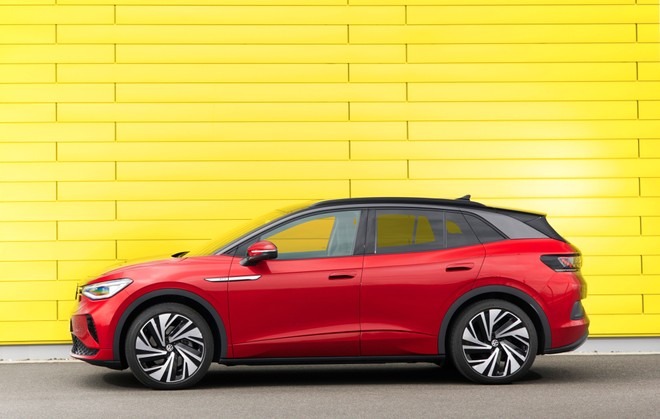Can an electric car be sporty? The answer to this question is yes. Usually, an electric car has batteries placed at the base of its car body and this allows it to have a low center of gravity. Still talking about the battery pack, this is placed between the two axles, useful for excellent weight management, and, in addition, we have the torque of the electric motor that ensures a nice boost.
Then let’s make it a little harder. Can an SUV, like the Volkswagen ID.4 GTX, with all the weight of its batteries and its important bulk, be considered sporty? With the ID.4 GTX, Volkswagen has been trying to transfer the sporty feeling of its GTI cars into the world of electric cars. To achieve this, he equipped his latest GTX with two electric motors and intelligent all-wheel drive.
AESTHETICS AND DESIGN
Aesthetically, the Volkswagen ID.4 GTX sports an aesthetic not too dissimilar to its younger sister, the more normal ID.4. In dowry, there is a revised front bumper, which leaves room for fingertip changes to the grille. Now the air intakes are painted black and the more extreme air vents have LEDs inside them.
It should be noted that the optical unit has an LED matrix and is available as standard. The car body remains muscular, with a high waistline and the possibility of equipping it with 20 or even 21-inch wheels. The GTX version stands out for the particularity of having the roof and the rear spoiler are always black, in spite of the color that we will choose for the bodywork, while an aesthetic anthracite gray tinsel connects the two uprights.
And in the queue? Here, too, the bumper changes in shape, with a hint of a gray diffuser and the 3D LED lights, joined by a subtle horizontal light signature that converges towards the Volkswagen logo. Needless to tell you. There are GTX badges scattered around the bodywork.
COCKPIT: I WON’T CHANGE YOU
The cockpit does not change in style and build quality. The sitting area is the same as we got to know when we boarded the younger sister ID.4. The “fingertip test” reminds me of the presence of rigid plastics and piano black, as well as the presence of softer covers for the upper part of the dashboard.
Here you are. Right on top of the latter, the ID.4 GTX differs in the presence of materials with dark coloring, specifically a midnight blue that contrasts with red stitching. The same color, blue with contrasting red stitching, can be found on the doors. Present the stainless steel pedals, a steering wheel with a revised design within the lower part – the GTX badge and the sports seats, enveloping enough but also sporty and containing the hips.
Excellent rear habitability. Without the central tunnel, there is enough room for the feet and legs, even sitting in the center of the sofa, not to mention that the space for the head and shoulders is much more than enough. There are several pockets, two USB-C sockets, and two air vents for our rear guests.
TECHNOLOGY INSIDE BUT ALSO OUTSIDE
Technology also wants its part and onboard the ID.4 GTX there is enough. Here, then, that among the spokes of the steering wheel is noticeable the digital instrument panel: small in size, only 5.3 in, but capable of containing a lot of useful information for driving. In addition to the canonical information on the odometers, we also have the radar for the adaptive Cruise and some info that comes from the navigator, not to mention the possibility of keeping an eye on the remaining battery. Its graphics are clear but I feel the need for a head-up display not to take your eyes off the road too much, this available is optional and that I highly recommend.
On the right side, the gaze continues its run meeting the gear selector, where it is also possible to activate the Brake function, which emphasizes the regeneration of energy during braking and release, giving us driving with a single pedal, using the accelerator. Finally, here is the infotainment display. Great. 10 or 12 inches.
Its touch is responsive and there are no physical buttons. Just a few touch buttons to set the climate or to refer to some quick and essential function (such as the choice of driving modes). Within the infotainment we find the menus also known on ID.4, therefore those to control climate, radio also DAB, telephone, media and to connect Android Auto And Apple CarPlay. There is also an additional menu to monitor the status of the battery recharge, its remaining, and the possibility of keeping its consumption under control.
The ADAS? There are. The Volkswagen GTX is technological inside but also outside. The assistance systems of the ID.4 GTX are grouped under the name IQ. Drive and include, as standard, the parking assistance system with acoustic warnings, assistance for lane maintenance Lane Assist and assistance in emergency braking Front Assist. On the other hand, the Travel Assist and Adaptive Cruise Control are optional.
ENGINES
Volkswagen ID.4 GTX is based on the modular electric platform (MEB) and features, as mentioned, four-wheel drive and two electric motors, one at the front and one at the rear. The maximum (overall) power is 299 CV (220 kW) and this allows it to burn the 0-100 km / h in 6.2 seconds, the 0-60 km / h in 3.2 seconds, and then stop at a maximum speed of 180 km / h, electronically limited.
Arm in arm, there is a 77 kWh battery which allows us to travel electric-only for 480 km (WLTP) and, thanks to a maximum charge power of 150 kW peak, it can be regenerated by 300 km of autonomy in less than 30 minutes. In the case of using a wallbox or home power, it will take about seven or eight hours to have a full recharge.
The lithium-ion battery alone weighs 486 kg. This is placed under the car body and this allows the ID.4 GTX to have a low center of gravity. Yet, if we adopt the Eco and Comfort driving modes, the overall weight of the electric SUV will be felt, hinting at lateral lying between the curves. For a sportier drive, it is better to choose the preset Sport mapping, than in the case of the presence of adaptive suspension of the Sport Plus package (on request) stiffens the set-up, mitigating the roll when cornering and giving more responsive steering and accelerator response.
In this case, the intervention of the XDS + electronic transverse locking system intervenes on the brakes by simulating what happens with a normal Torque Vectoring. Also noteworthy is the possibility of choosing between the preset Individual mode (which allows us to tailor the response of the steering, accelerator, and shock absorbers) or the Traction mode which makes the torque sweeter and is designed for slippery surfaces.
So, answering the initial question of this paper, does the Volkswagen ID.4 GTX manages to give the same sensations as a GTI? Ni. It certainly demonstrates that sustainable mobility and playful driving can go hand in hand, with the ID.4 GTX that manages to give a good feeling of sportiness, especially in acceleration.
CONSUMPTION REGISTERED
Taking into account the consumption that the onboard computer communicated to me, during the first 100-kilometer stretch of road I tested the sporty side of the ID.4 GTX, recording 27.5 kWh / 100 km. In the second part of the route, I set the Eco mode and the Brake mode to emphasize the regeneration of the braking, recording consumption of 20.5 kWh / 100 km. Volkswagen ID.4 GTX can already be ordered in Italy. The starting price is 54,650 euros.
TECHNICAL FEATURES
- Motor: two electric motors
- Power: 299 HP
- Torque: 472 Nm
- Vel. max: 180 km / h
- 0 to 100 km / h: 6.2 seconds
- Four-wheel drive
- Dimensions: 4.58 x 1.85 x 1.61m Wheelbase 2.77m
- Seats: 5
- Weight: 2.211 kg
- Luggage compartment: from 543 to 1,575 liters
- Lithium-ion battery: 77 kWh
- Autonomy: 480 km
- Max power recharge 150 kW in DC
- Price: starting from 56,850 euros



